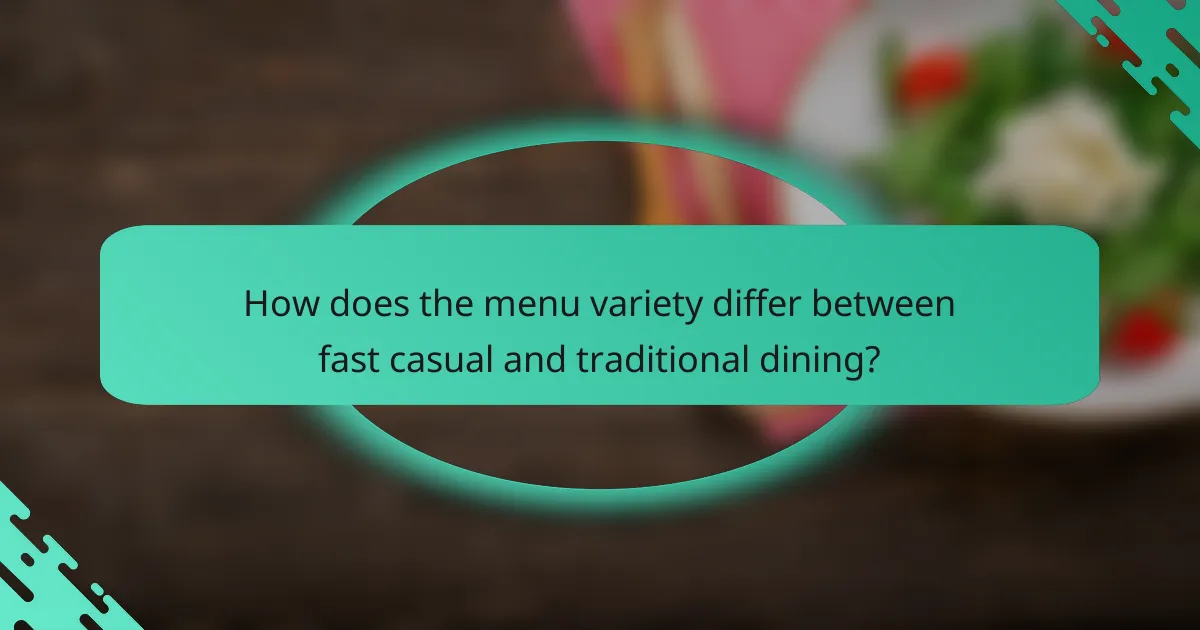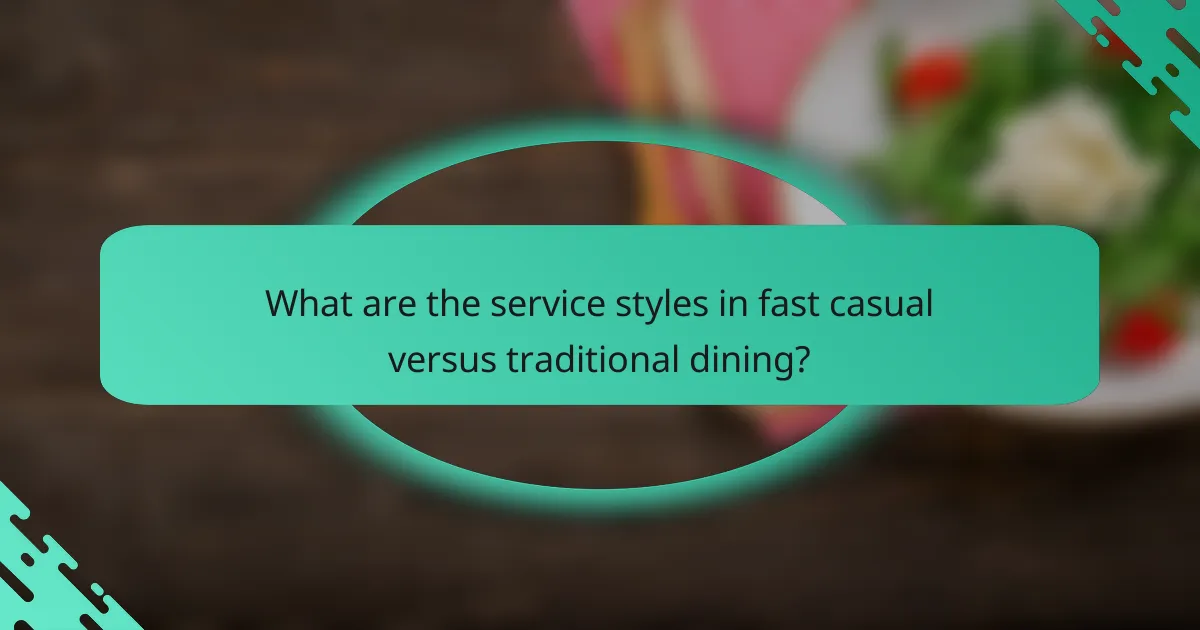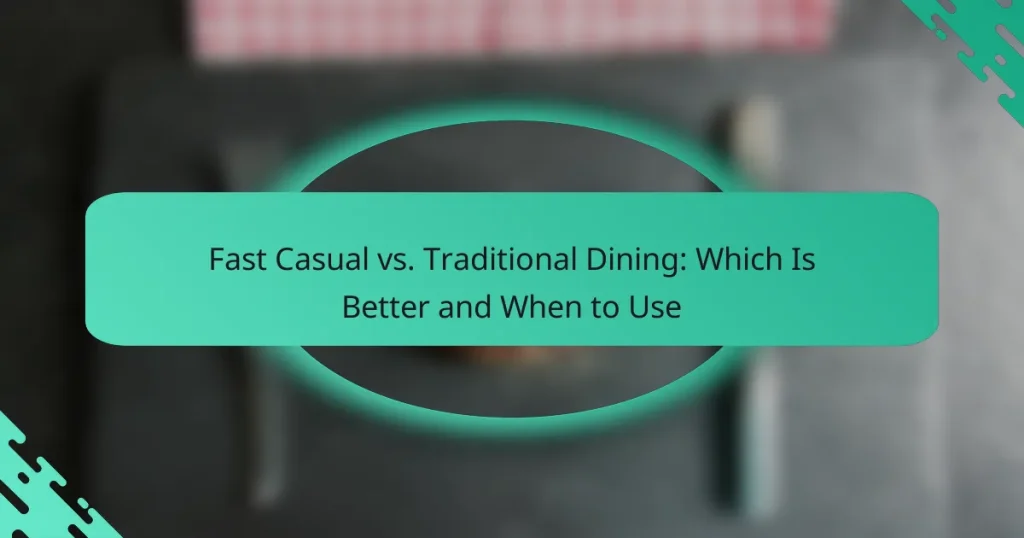Choosing between fast casual and traditional dining depends on your needs and occasion. Fast casual offers a quick, budget-friendly option without compromising on quality, making it suitable for busy lifestyles. In contrast, traditional dining provides a more refined experience with exceptional service and atmosphere, perfect for special occasions or leisurely meals.

When should you choose fast casual dining in Los Angeles?
Fast casual dining in Los Angeles is ideal when you need a quick meal without sacrificing quality. This dining option combines the convenience of fast food with a more upscale menu, making it perfect for those with busy lifestyles or budget considerations.
Quick service for busy schedules
Fast casual restaurants typically offer quick service, allowing you to place your order and receive your meal in a matter of minutes. This is particularly beneficial for lunch breaks or when you’re on the go. Many establishments in Los Angeles have streamlined their processes to minimize wait times, often using digital ordering systems to enhance efficiency.
Consider visiting during off-peak hours to further reduce wait times. Early lunches or late dinners can provide a more relaxed experience while still ensuring speedy service.
Affordable meal options
Fast casual dining often features menu items that are more affordable than traditional sit-down restaurants, typically ranging from $10 to $20 per meal. This makes it a great choice for budget-conscious diners looking for quality food without the higher price tag associated with full-service dining.
Look for specials or combo deals that many fast casual spots offer, which can provide even better value. In Los Angeles, you can find a variety of cuisines at competitive prices, making it easy to enjoy diverse meals without overspending.
Casual dining atmosphere
The atmosphere in fast casual restaurants is generally relaxed and informal, making them suitable for a variety of occasions. Whether you’re grabbing a quick bite with friends or enjoying a solo meal, the casual setting encourages a laid-back dining experience.
Many fast casual venues in Los Angeles feature modern decor and comfortable seating, which can enhance your overall enjoyment. This environment is especially appealing for those who prefer a more social dining experience without the formality of traditional restaurants.

What are the benefits of traditional dining in San Francisco?
Traditional dining in San Francisco offers a unique culinary experience characterized by high-quality food, exceptional service, and a sophisticated atmosphere. It is ideal for special occasions or when you want to enjoy a leisurely meal with attention to detail.
Fine dining experience
The fine dining experience in San Francisco is marked by elegant settings and meticulously crafted menus. Restaurants often feature renowned chefs who create seasonal dishes that highlight local ingredients. This level of dining typically includes multiple courses, allowing guests to savor each dish and enjoy the overall ambiance.
Reservations are often recommended, especially at popular venues, to ensure you secure a table during peak dining hours. Dress codes may apply, so it’s wise to check in advance to match the restaurant’s expectations.
Higher quality ingredients
Traditional dining establishments prioritize high-quality ingredients, often sourcing them from local farms and markets. This commitment to freshness not only enhances the flavor of the dishes but also supports the local economy. Many restaurants in San Francisco take pride in offering organic, sustainable, and seasonal options.
When dining out, look for menus that highlight these ingredients. For example, a dish featuring locally caught seafood or farm-fresh vegetables can provide a taste of the region’s culinary heritage.
Full-service experience
A full-service experience in traditional dining means attentive waitstaff, expertly paired wine selections, and a focus on customer satisfaction. From the moment you enter, you can expect personalized service that enhances your meal. Staff are typically well-trained to provide recommendations and accommodate dietary restrictions.
Consider opting for wine pairings or tasting menus, which can elevate your dining experience. This level of service often justifies the higher price point, as it transforms a meal into a memorable event.

How do fast casual and traditional dining compare on pricing?
Fast casual dining typically offers lower prices compared to traditional dining, making it a popular choice for budget-conscious diners. The pricing structures reflect the dining experience, with fast casual focusing on quick service and convenience.
Fast casual is generally more affordable
Fast casual restaurants often feature a menu with items priced in the low to mid-range, usually between $8 to $15 per meal. This pricing appeals to a wide audience, especially those looking for a quick and satisfying meal without breaking the bank.
Additionally, fast casual establishments frequently offer value deals, such as combo meals or discounts for larger orders, making them an economical choice for families or groups. The emphasis on counter service also helps keep operational costs lower, which can translate to savings for customers.
Traditional dining has higher price points
Traditional dining establishments typically have higher price points, often ranging from $15 to $50 or more per person, depending on the cuisine and dining experience. This pricing reflects the full-service model, where patrons receive table service and a more extensive menu.
In traditional dining, factors such as ambiance, quality of ingredients, and chef expertise contribute to the overall cost. Diners should expect to pay more for a multi-course meal or fine dining experience, which often includes higher-end wines and desserts.

What factors influence the choice between fast casual and traditional dining?
The choice between fast casual and traditional dining is influenced by various factors including the occasion, time constraints, and group size. Understanding these elements can help diners select the most suitable dining experience for their needs.
Occasion and event type
Different occasions call for different dining experiences. Fast casual dining is often preferred for casual gatherings, quick lunches, or informal meet-ups, while traditional dining is more suitable for celebrations, business meetings, or special occasions that require a more formal atmosphere.
For example, a birthday dinner or anniversary celebration typically benefits from the ambiance and service of a traditional restaurant, whereas a quick lunch break at work might be best served at a fast casual spot.
Time constraints
Time constraints play a significant role in choosing between fast casual and traditional dining. Fast casual restaurants generally offer quicker service, making them ideal for those with limited time, such as during a lunch break or between appointments.
In contrast, traditional dining often involves longer wait times for food and service, which can be a drawback for diners who need a swift meal. If you have less than an hour, opting for fast casual can ensure you get your meal without feeling rushed.
Group size considerations
The size of your group can also influence your dining choice. Fast casual restaurants usually accommodate smaller groups efficiently, making them great for casual outings with friends or colleagues.
For larger gatherings or family celebrations, traditional dining venues often provide more space and a wider range of menu options, which can enhance the dining experience. Consider the size of your party when making a reservation to ensure everyone is comfortably accommodated.

How does the menu variety differ between fast casual and traditional dining?
The menu variety in fast casual dining typically features a limited selection of diverse options, while traditional dining offers extensive menus with a wide range of choices. Understanding these differences can help diners select the right dining experience based on their preferences and needs.
Fast casual offers limited but diverse options
Fast casual restaurants usually focus on a smaller menu that emphasizes quality and freshness. Diners can expect a variety of items, often including customizable options like build-your-own salads, sandwiches, or bowls. This model allows for quick service while still catering to diverse tastes.
For example, a fast casual eatery might offer a selection of proteins, grains, and toppings, allowing customers to create a meal that suits their dietary preferences. This approach is particularly appealing for those seeking healthier or more unique meal options without the lengthy wait times typical of traditional dining.
Traditional dining features extensive menus
In contrast, traditional dining establishments often boast extensive menus that cover a wide array of cuisines and dishes. These menus can include appetizers, entrees, desserts, and beverages, providing diners with numerous choices for a more leisurely dining experience.
For instance, a traditional restaurant may offer multiple options for each course, allowing guests to explore various culinary styles and flavors. This variety can enhance the dining experience, making it suitable for special occasions or when diners want to enjoy a more elaborate meal.

What are the service styles in fast casual versus traditional dining?
Fast casual dining typically features a counter service model, while traditional dining relies on table service. Each style offers distinct experiences in terms of speed, cost, and atmosphere, influencing when to choose one over the other.
Counter service in fast casual
Counter service in fast casual restaurants allows customers to place their orders at a counter and often pay upfront. This model emphasizes speed and efficiency, making it ideal for those looking for a quick meal without the formality of traditional dining.
Customers usually receive their food shortly after ordering, often within minutes. Popular examples include chains like Chipotle and Panera Bread, where patrons can customize their meals and enjoy a casual environment.
When opting for counter service, consider the trade-off between speed and service quality. While you save time, you may miss out on personalized attention that comes with table service.
Table service in traditional dining
Table service in traditional dining involves waitstaff taking orders and serving food directly to customers at their tables. This style promotes a more leisurely dining experience, often accompanied by a more extensive menu and higher prices.
Restaurants like Olive Garden or local bistros exemplify this model, where patrons can enjoy a full meal with multiple courses. The experience is typically more formal, allowing for greater interaction with staff and a focus on customer service.
When choosing table service, be prepared for longer wait times and potentially higher costs. However, this setting is ideal for special occasions or when you want to savor your meal in a relaxed atmosphere.

How do customer experiences differ in fast casual and traditional dining?
Customer experiences in fast casual and traditional dining vary significantly in terms of service speed and overall atmosphere. Fast casual dining prioritizes quick service and convenience, while traditional dining emphasizes a more relaxed environment with attentive service.
Fast casual emphasizes speed and convenience
Fast casual restaurants are designed for customers seeking quick meals without sacrificing quality. Typically, patrons order at a counter and receive their food in a matter of minutes, allowing for a swift dining experience. This format appeals to busy individuals or families looking for a meal on the go.
Menu options in fast casual dining often include customizable items, such as build-your-own salads or sandwiches, which cater to diverse dietary preferences. Prices generally range from $8 to $15 per person, making it an affordable choice for casual dining.
Traditional dining focuses on ambiance and service
Traditional dining establishments aim to create a memorable experience through a focus on ambiance and personalized service. These restaurants often feature table service, where waitstaff attend to guests, enhancing the overall dining experience. Customers can expect to spend more time enjoying their meals, typically ranging from 1 to 2 hours.
The menu in traditional dining is often more extensive, featuring multiple courses and higher-quality ingredients. Prices can vary widely, usually starting around $20 per person and going up significantly for fine dining experiences. This setting is ideal for special occasions or leisurely meals with friends and family.


